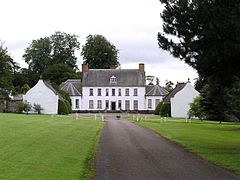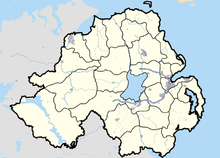- Springhill House
-
Springhill House House information Location Moneymore, County Londonderry Coordinates 54°41′10″N 6°39′22″W / 54.686°N 6.656°WCoordinates: 54°41′10″N 6°39′22″W / 54.686°N 6.656°W Built c.1680-1689 with notable extensions c.1765 and c.1820 Governing body National Trust Springhill is a 17th century plantation house[1] in the townland of Ballindrum near Moneymore, County Londonderry in Northern Ireland. It has been the property of the National Trust since 1957[2] and, in addition to the house, gardens and park, there is a costume collection and a purported ghost.[3][4] It is open from March to June, and September on weekends, and is open to the public seven days a week during July and August.[5]
Contents
Features
This 17th century unfortified houses was built about 1680 and was originally surrounded by a defensive bawn. Around 1765 two single-storey wings were added and the entrance front was modified to its present arrangement of seven windows across its width.[6]
History
Conyngham family
The Conyngham family had come from Ayrshire in Scotland in about 1611 and were granted lands under James I's Plantation of Ulster in County Armagh. They purchased the Springhill estate in around 1630. It is believed that some form of farm dwelling was constructed on the estate at this time (probably on the site of the present carpark) but this was almost certainly destroyed during the Irish Rebellion of 1641.
William Conyngham II
Marriage articles between William Conyngham II and Ann Upton of Castle Upton near Templepatrick executed 1680[3] stated that he was required "to build a convenient house of lime and stone, two stories high ... with necessary office houses" for his wife-to-be. It is widely believed that the present house owes its origin to this document though dendrochronological examination of the roof timbers on the central part of the house date the beams to after 1690. At this time, many of the surviving outbuildings along with the rare Dutch styled gardens were created. The gardens are currently undergoing a process of restoration.
Butle Conyngham
From William Conyngham II (better known as "Good Will"), the estate passed to his nephew George Butle in 1721 who thereupon adopted the name Butle Conyngham. Under the terms of the Plantation Grant, he constructed the village of Coagh in about 1755, naming the main square Hanover Square in deference to King George II.
Col. William Conyngham
From George Butle Conyngham, the estate passed to his eldest son, Col. William Conyngham of the Black Horse Regiment in 1765. Col William added the two wings to either side of the house as a nursery and ballroom respectively.
Lenox-Conyngham
As Col. William did not marry until the age of 52, he died without issue. The estate passed to his brother David Conyngham who also died childless. As a result, the estate passed to the son of their sister Ann who had married Clotworthy Lenox of Derry. Col. George Lenox, upon inheriting the estate, adopted the name Lenox-Conyngham and his descendants lived in the house until 1957. George served under Castlereagh in the Irish Volunteers but, after being betrayed by Castlereagh, resigned his commission in disgrace in 1816. As a result of this, combined with his depressive nature, he committed suicide later that year. His wife Olivia (née Irvine of Castleirvine in County Donegal) is said to haunt the house to this day and is reputed to be the best documented ghost in Ireland.
Lissan House connection
From George, the house passed to his eldest son William Lenox-Conyngham. He had been a talented lawyer in Glasgow but left his legal career in order to run the estate. In 1818 he married Charlotte Staples, daughter of the Rt. Hon. John Staples of Lissan House near Cookstown. John Staples was a well known lawyer and orator and was the last speaker in the Irish House of Commons in 1801. During William Lenox-Conyngham's tenure, the estate was drained and improved and a large well-appointed dining room was added to the rear of the house, complete with a 17th-century Italian chimneypiece salvaged from Frederick Augustus Hervey's (the Earl of Bristol and Bishop of Derry) Ballyscullion House near Bellaghy which was demolished in about 1825.
Sir William Lenox-Conyngham
When William Lenox-Conyngham died in 1858, the estate passed to Lt. Col. Sir William Fitzwilliam Lenox-Conyngham who had married Laura Arbuthnot of Aldershot in 1856. Sir William was highly involved in military matters and was knighted (KCB) by Queen Victoria in 1880. During his tenure, the estate was largely sold off under the Ashbourne and Wyndham Acts and was reduced to around three hundred acres. Finances became a grave concern for the family.
Decline of the Estate
By the time of Sir William's death in 1906, there was little left of the estate and as a result of some unwise investments, his son Lt. Col. William Arbuthnot Lenox-Conyngham found financial matters very trying. In 1899 he married Mina Lowry of Rockdale near Cookstown in County Tyrone. She was the last member of the family to reside on the estate and she continued to do so even after the death of her son and the National Trust taking over in 1957 until her own death in 1960. Col. William Arbuthnot fought in both the Boer and Great Wars and his younger brother Lt. Col. John Staples Molesworth Lenox-Conyngham was killed during the taking of Guillemont in September 1916, leading the VI Battalion Connaught Rangers to the Front armed only with an ancient revolver. He is buried at Carnoy in France.
National Trust
William Arbuthnot died in 1938 and the estate passed to his elder and somewhat sickly son Capt. William Lowry Lenox-Conyngham who led the local Home Guard during the Second World War as a result of being invalided out of the National Defence Corps in 1940. Realising that the finances of the family were now in terminal decline and recognising that neither he nor his brother had any children to carry on the line, William Lowry entered into negotiations with the National Trust in 1956 with a view to handing over the house. This had followed a chance meeting with Nancy, Countess of Enniskillen who had presented Florence Court in County Fermanagh to the Trust the previous year. In the event, he signed his will bequeathing the house and estate to the National Trust only three days before his death in 1957.
Restoration
Upon adopting the property, the National Trust undertook a large-scale programme of restoration and re-construction adopting the orthodoxy of 1950's conservation practice which saw the Victorian smoking room demolished, large portions of the house stripped back to stone and all the rooms re-arranged to reflect their appearance when first constructed.
Present day
The house today contains a vitally important and almost complete collection of one family's occupation for three hundred years. In the Gun Room can be found one of the largest surviving 18th century wallpaper schemes surviving in the UK, along with a "long gun" dating to about 1680 which was presented to Alderman James Lenox after the Siege of Derry. The Library contains one of the most important collections of 17th and 18th century books in Ireland and is composed of around 3000 volumes, the oldest of which is a small Latin psalter of 1541.
In the old laundry can be found the largest costume collection in Northern Ireland (established by Viscount Clanwilliam in 1960) and a selection from the collection is displayed annually in the costume museum.
Wellbrook Beetling Mill
The National Trust owned Beetling Mill is a sister property of Springhill.
References
- ^ http://www.inyourpocket.com/ni/belfast/sightseeing/venue/28574-springhill_house.html
- ^ Houses, Castles and Gardens of Ireland-16a Woodlands Park Blackrock Co Dublin Ireland
- ^ a b Springhill House
- ^ Springhill House And Costume Collection Derry. Find and Reserve your Homes Historical in Derry, Ireland
- ^ National Trust | Springhill
- ^ O'Neill, B (ed). (2002). Irish Castles and Historic Houses. London: Caxton Editions. p. 18.
External links
- National Trust - Springhill
- Virtual tour of Springhill House - Virtual Visit Northern Ireland
- Public Record Office of Northern Ireland - Lenox-Conyngham Papers
- The Ghost Club - Autumn 2002
- National Trust
- Lenox-Conyngham family tree
Book
- Mina Lenox-Conyngham, An old Ulster House and the people who lived in it 1946 and 2005 ISBN 1-903688-38-8
National museums Northern Ireland Environment Agency Ballycopeland Windmill · Bellaghy Bawn · Carrickfergus Castle · Castle Archdale Country Park · Derry City Walls · Devenish Monastic Site · Dundrum Castle · Dunluce Castle · Greencastle · Grey Abbey · Harry Avery's and Newtownstewart Castle · Hillsborough Courthouse · Inch Abbey · Jordan's Castle · Monuments and Buildings Record · Navan Fort · Nendrum Monastic Site · Tullaghoge · Tully CastleNational Trust Ardress House · The Argory · Carrick-a-Rede Rope Bridge · Castle Coole · Castle Ward · Crom Estate · Crown Liquor Saloon · Derrymore House · Downhill Estate (Mussenden Temple) · Florence Court · Giant's Causeway · Gray's Printing Press · Hezlett House · Mount Stewart · Murlough Nature Reserve · Patterson's Spade Mill · Rowallane Garden · Springhill House · Wellbrook Beetling MillOther museums and galleries Categories:- National Trust properties in Northern Ireland
- Buildings and structures in County Londonderry
- Historic house museums in Northern Ireland
- Grade A listed buildings
- Museums in County Londonderry
- Fashion museums in the United Kingdom
- Country houses in Northern Ireland
Wikimedia Foundation. 2010.



